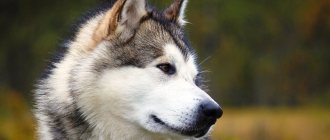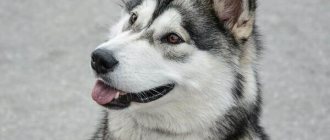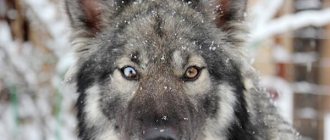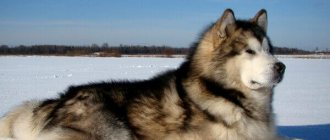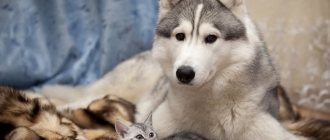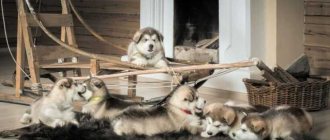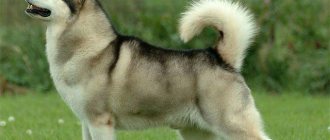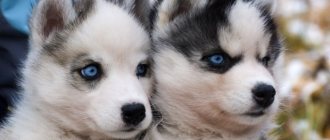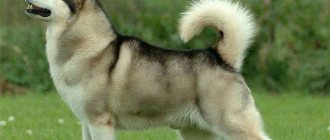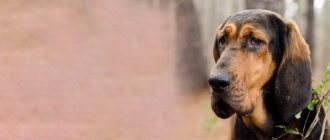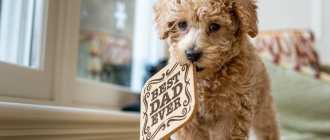The Malamute standard emphasizes the anatomical features that allowed these dogs to survive in the harshest conditions. The dogs lived outside in weather that often dropped to 50 degrees below zero. When food was scarce, they ate only once every few days and still worked very hard. To protect the dogs in these extreme conditions, the dogs needed a rough coat with a dense undercoat. Good, strong legs are also important for survival in the Arctic. The standard requires large, compact paws that help the dog distribute its weight across the snow. Small, thick, well-furred ears are less susceptible to freezing. Almond-shaped, obliquely set eyes minimize exposure to sunlight reflected from the snow. A bulging eye can freeze. The flat back of the skull, bulky muzzle and slightly sloping nose prevent snow from accumulating on the dog. Characteristics such as the structure of the tail, the position of the ears and dark eyes are not necessary for the dog's survival, but they help make the dog a Malamute.
The environment also influenced the character of the Malamute. The dogs lived in small packs. The Inuit are a nomadic people and traveled throughout the Arctic, rarely meeting with other family groups. The Malamute is not a watchdog, but it will tell you if there is any creature nearby. He is not particularly devoted to one person or family, but must be affectionate with all people. Most Malamutes love children. Because they never knew when they would be able to eat, dogs are prey-oriented and will attack any furry, feathered or swimming creature they encounter. If they grew up with cats or other animals, they will usually be friendly with them, but strange cats are fair game. Malamutes can be aggressive with same-sex dogs, but they usually get along well with each other.
As noted above, Malamutes were bred to pull heavy loads at slow speeds. Jamie Nelson, a musher who has competed in the race, says that with other breeds, you can take a short nap on the trail, but the dogs will continue to run and follow the scent without support. If you try to take a nap with a team of Malamutes, they just stop. In the Arctic, calories are valuable, and Malamutes see no reason to waste them if they don't have to. Conserving energy is a Malamute's survival strategy.
History of the origin of the breed
One of the oldest dog breeds native to North America is the Alaskan Malamute. It can also be assumed that these dogs live side by side with humans longer than others; have been domesticated and tamed before. This fact is supported by the fact that DNA analysis showed their close relationship with wolves (domesticated wolves are recognized as their ancestors). About 14 thousand years ago, animals moved from Central and East Asia to North America, crossing the Bering Strait.
Interesting results were also obtained by comparing the DNA of Alaskan Malamutes, as well as Siberian Huskies and Alaskan Klickies. The results were impressive: if previously it was believed that these dogs are distinguished only by the presence of a common ancestor, but they are also related to each other. The main difference between the breeds is that Malamutes have heavier bones and are somewhat larger and heavier than their relatives.
The history of this breed began in the harsh conditions of the north, where they lived with the nomadic Eskimo peoples as full members of the tribe. Men often took them hunting; Animals also protected people’s homes and property. Over time, Malamutes also began to be used as sled dogs.
It was the difficult climate and difficult living conditions that played a fundamental role in the formation and development of the breed: evolution generously rewarded the animals with physical strength, endurance, and the ability to endure hardships. The species' range expanded over time, covering new territories, in particular the Anvik River basin.
Europeans managed to discover this breed towards the end of the 19th century. This phenomenon is explained by the fact that the Gold Rush began in 1896. And thousands of people, in pursuit of quick enrichment, rushed to the Klondike. Since difficult conditions made it necessary for visitors to quickly move around the area, and the main means of transportation was dog sleds, there was interest in animals well adapted to this. Malamutes met all the requirements for sled dogs; therefore, the demand for them grew. But prices for dogs of this breed have also increased significantly - one individual could cost at least $500; and for a team they could demand from one and a half thousand. Nevertheless, after a short time, Malamutes became the most sought after and expensive dogs in that area.
Over time, people who arrived in North America began to bring St. Bernards, as well as Newfoundlands, to the continent. In the hope of obtaining breeds with more developed strength qualities, they began to cross them with Malamutes. However, hopes were not justified. When dog sled racing gained popularity, there were also attempts to put animals in one team, however, this experiment also failed: the dogs could not work harmoniously, and skirmishes broke out between them all the time. But the Malamutes themselves turned out to be indispensable in this matter - for example, the famous All Alaska Sweepstakes race of 1908, where dogs had to cover a distance of 408 miles, significantly increased the prestige of the breed.
Crossing Malamutes with other dogs had another purpose. Although the stamina that later became the hallmark of this breed set them apart from other dogs, many other characteristics - such as endurance, as well as the ability to work in a team - were never their strong point. However, the activity aimed at obtaining a new breed also had a downside - for example, due to the active crossing of Alaskan Malamutes with dwarf dogs, it led to the fact that there were practically no purebred dogs left.
A group of breeders volunteered to prevent the final extinction of the animals, and for two decades they divided the breed into three basic lines: M'Loot, Hinvan-Irvine and Kotzebue. However, plans to revive the breed were disrupted by the Second World War. Once the dogs were involved in active combat, they suffered significant losses. And by 1947, there were no more than thirty individuals in the world. In order to prevent the extinction of the species, breeders had to look for a compromise solution and deviate somewhat from the breed standards.
Currently, the breed has not only managed to survive, but is also successfully developing and remains one of the most popular in the world. And today the dog, originally used as a sled dog, is still in demand in this field due to its phenomenal endurance and exceptional performance. And besides, it is one of the official symbols of Alaska.
Price
The price of an Alaskan Malamute depends on its pedigree. An animal without one can be purchased for 10-12 thousand rubles. A puppy from purebred parents will cost over 25 thousand rubles. An animal born from dogs that have a number of titles and awards costs more than 35 thousand rubles.
Malamutes are very beautiful and gentle creatures, they love children and never conflict. But before you buy a dog, it is recommended that you once again read the information presented above. This will help avoid not only mistakes in parenting, but also disappointment.
Malamute breed standard
What is a Malamute? The description of the breed is as follows. The trait that distinguishes Malamutes - dogs of this breed - is developed muscles and large bones, because of which they are very similar in appearance to wolves. This is an exceptionally strong and at the same time agile sled dog. Despite her rather impressive build, she is quite compact; the animal's body is covered with thick and coarse hair; the undercoat is soft. Breed characteristics:
- The height at the withers of males ranges from 58 to 60 cm (for females) and from 60 to 64 cm (for males).
- The animal's head is large, but at the same time proportional to the body in size. The muzzle is also voluminous, but it is not elongated and does not have a pointed shape.
- The dog is distinguished by powerful jaws, large and sharp teeth, and a scissor bite. The lips are tightly closed.
- The animal's eyes are set slightly askew; they are almond-shaped and most often brown. Size is medium.
- The dog's triangular ears are elegant, erect, and slightly rounded at the ends. They are located far from each other.
- The nose is most often colored black; the only exception is the red Alaskan Malamute (their nose has a brown tint).
- The dog's strong, slightly arched neck gives it a special grace.
- The chest is quite wide. The back is straight, the lower back is strong and muscular. The tail, when at rest, rises above the animal's back.
- The Alaskan Malamute's coat is one of the animal's most distinctive features. Since this dog first inhabited the northern territory, it is moderately tough, but at the same time it has a rather soft fluffy undercoat and is a little oily (this feature should protect the dog from hypothermia and makes it waterproof). Long-haired Malamute.
- Smooth, parallel limbs in appearance slightly resemble bear paws. The bone is wide, the muscles are well developed.
- Acceptable coat color ranges from gray and sometimes bluish to white and black.
- The Malamute girl is different in that her first heat begins between eight months and a year.
Varieties
Today there are two main varieties of the breed - M'Lut and Kotzebue. Despite the fact that experts have not yet figured out which variety has the best qualities, each of them within the species has its own advantages and disadvantages.
And also, Canadian, Caucasian, English, American, and Siberian Malamutes can be classified into a separate category. Each line has its own characteristics. For example, Canadian dogs are characterized by extremely low aggressiveness, while Asian (in particular Siberian) dogs demonstrate high affection for children. The physically strongest malamutes live in Yakutsk; Altai has become home to the largest individuals of this breed.
M'Luth
Size and weight
Considering how much an adult dog should weigh, we note that the body weight of the animal as a whole depends on gender: the standard norm for females is 34 kg, while for males it is slightly larger and amounts to 38 kg. The average height of a male is 63–64 cm, a female is 58–59 cm.
Color and coat type
The nature of coat color is influenced primarily by the characteristics of the intrabreed line. For example, the M'Lut line has colors such as black and white, brown and white, white and red, and even blue. The Kotzebue line has a gray “wolf” color.
Kotzebue
Mating
Malamute females begin puberty around the eighth month of life. One to two weeks before the first heat, the pet begins to exhibit strange behavior and urinate frequently, which is completely normal.
The first heat takes place in two stages:
- Mucous and bloody discharge appears (at this moment it will not be possible to breed - the female will not allow the male to come to her). This lasts for about ten days;
- Transparent discharge appears (mating can begin).
However, experienced breeders do not recommend breeding during the first heat, otherwise the offspring will be weak.
For the first mating, you can ask the breeder which cable is best to choose. The most important thing is that both Malamutes are healthy.
How is the knitting itself carried out? Usually mating is carried out in the morning (on an empty stomach).
There are two types of matings:
- Free – when they tie up already experienced parents who are not getting together for the first time;
- Manual – when the bitch is inexperienced and the couple needs help.
In the case of the second one, you need to act carefully. First, the dogs must get acquainted (this should take at least two hours). Then, to avoid injury, put a muzzle on the female and attach a cable. First you just need to put his paw on his back. This creates the illusion for the female that the cable has straddled her. And then mating already occurs. It can last from 15 to 40 minutes, and it is better to repeat it after 24-48 hours. If the mating was successful, you can expect a replenishment.
In the first month of pregnancy, you should not reduce the load; this will not harm the health of either the mother or the puppies. But in the second month it is better not to burden her with heavy exercises and switch to a lighter diet.
Approximately 10 hours before birth, pushing begins, and the pet begins to behave restlessly. At this moment it is better to take her to the sun lounger and not leave her side
You shouldn’t forcefully hold her on the lounger; it’s better to just turn the attention to yourself with your affection. But as soon as labor begins, it’s better not to touch the mother
And after childbirth, you shouldn’t bother your family either. The mother must understand the new situation and begin feeding her children.
After some time, you need to call the female to you and wipe her genitals with a warm, clean rag. To do this, ask one of your relatives to take the Malamute for a walk and check for weak or underdeveloped puppies. They usually don’t leave them, because the chance that they will survive is negligible.
Health and illness
The harsh northern climate had a beneficial effect on the animal's health. But the Alaskan Malamute is characterized by two of the most common genetic diseases. They need to be detected before the puppy is born; This is why it is much more important to purchase animals from professional breeders.
- "Snow Nose" With this disorder, the animal experiences a disruption of nasal pigmentation; and instead of the usual black pigmentation, it is characterized by pink. With this disease, it is extremely undesirable for an animal to stay under the sun for a long time; he has a high sensitivity to ultraviolet radiation. Such a disorder, in principle, can be treated - for this purpose, the dog is given a special tattoo. However, breeders take such individuals under special control in order to subsequently prevent their crossing and further transmission of the gene responsible for the transmission of the disease.
- Chondrodysplasia is a disease that manifests itself in impaired development of cartilage tissue. And if the animal does not receive timely treatment and the owner does not take measures to eliminate the consequences of the disease, it will first lose the ability to run, and then to walk altogether. Symptoms of this disease begin to appear gradually, but increasingly. These include increased fatigue after physical exertion, and then he is reluctant to participate in outdoor games with other dogs and children. In later stages, the dog becomes lethargic and spends most of the time lying with its limbs outstretched.
In rare cases, Alaskan Malamutes may also develop polyneuropathy, hemophilia, diabetes, some eye diseases (glaucoma, cataracts, hemeralogia), and some skin diseases (demodex, atopic dermatitis).
Lifespan
How long do Malamutes live? Quite a long time by animal standards - on average, dogs of this breed can live from 12 to 15 years.
Training needs
Malamutes love to exist in high energy environments - they will happily join in on hikes, runs, walks, swimming and more! Malamutes need daily exercise, up to twice a day, depending on your dog's personal needs and how much space he has. Malamutes thrive on cold weather, so don't be surprised when your Malamute tries to take you outside in the middle of a snowstorm.
Inadequate exercise will lead to frustration and destruction, so it is important to introduce your Malamute to an active family that will adequately tax the puppy mentally and physically. The Malamute is a dog that seeks a challenge, so it can be given a load to carry or taught to push a sled at a young age. A full canine pack will be enough for the average owner when hiking, so let him carry his own water and treats—and maybe your load, too!
Characteristics of the Malamute breed
When deciding to get a Malamute, you must remember that although representatives of this breed are not alien to such qualities as devotion and affection for their owner, reciprocity on the part of the owner is extremely important for them. And if a person has to offend the animal with something, to cause offense, this threatens a complete loss of trust and “switching” attention to someone else, in addition, the dog is tired of daily repetitive actions, from which he gets tired and can even be regarded as disrespect for himself . All this can significantly harm a person’s authority.
And also a distinctive feature of the Malamute is its need for a pack or family - it needs to live among people or animals. He is extremely uncomfortable in enclosed spaces; This is why keeping an Alaskan Malamute in an enclosure is impossible. Being alone for a long time, the dog becomes closed and withdrawn.
Attitude towards children and others
Most Malamutes are friendly and friendly animals. In addition, they love attention to themselves. This is what makes dogs of this breed absolutely irreplaceable in large families, where they happily take on the role of four-legged nannies, playing with children and looking after them when their parents are not around. However, it is still undesirable to leave them alone with children: the impressive size of the dog can frighten the child, and the animal can inadvertently touch or push him.
Dogs are also very friendly towards strangers. They are capable of showing aggression towards strangers only in cases where their behavior poses a real threat to the owner or his family. Therefore, guests should not be afraid of Malamutes. Even with their impressive size, they are very calm and peaceful.
Energy level
Malamutes were bred to be working dogs and require daily exercise to keep them mentally and physically stimulated. Some traits are hard to break, such as the urge to dig, so it is helpful to find a positive outlet for this breed.
The Malamute is a great companion for those who love to explore, hike, swim, and spend time in the snow. These dogs will show their true personality when given the chance to run around in the snow, so be prepared for a playful and energetic dog when they encounter their native climate.
Training and education
Malamutes are quite trainable and easy to train - even despite all their stubbornness. Thanks to their well-developed memory and curiosity, they are quite capable of easily remembering and assimilating commands. However, as we indicated above, they really do not like monotonous repetitive actions and therefore will execute the proposed command once at most twice. Therefore, if the owner notices that the dog has become irritable, angry, and refuses to follow commands, he definitely needs to be given a break. And only after that resume training.
In general, for successful dog training, it is necessary for the owner to comply with three important conditions:
- Start training from the moment the puppy arrives at its new home. This will minimize manifestations of stubbornness.
- Be persistent. The Alaskan Malamute dog is far from being one of those dogs that will easily trust a person and recognize his authority. And if at the right moment a person does not show strength of character and leadership qualities to the pet, it will be extremely difficult to achieve anything from him.
- Smart control. The Malamute breed is stubborn and persistent. If not properly controlled, there is a risk that these qualities may develop into more serious behavioral problems in the future; Simply put, the dog can become completely uncontrollable. It is important to stop any violation of the rules of behavior by the dog.
Environmental needs
The Malamute thrives in cold climates such as Siberia. Malamutes can adapt to other environments, but warmer climates will require special care and attention as the breed is designed to withstand cold, not extreme heat.
Malamutes are best suited to homes with fenced yards. Make sure the fence is buried in the ground because Malamutes love to dig and will happily escape and run around the area. It is difficult to completely stop this behavior, so instead, you can provide a designated digging area, such as a sandbox, so that your Alaskan Malamute can take part in one of its favorite activities.
Pros and cons of the breed
Stubbornness and incredible endurance - these qualities can be parallel to both the advantages and disadvantages of the breed. Why?
Fans of outdoor activities will certainly appreciate the character of the Malamute, namely the animal’s desire to always be close to its owner and good mutual understanding. And the love of long walks will be useful for hikers, who will be able to calmly take them with them, without fear of leaving them without attention and care for a long time.
But this breed is not without its disadvantages.
- First of all, it should be noted that with its impressive dimensions, impressive physical strength and endurance, consider this dog as a guard dog. The reason lies mainly in the fact that representatives of this breed are extremely non-aggressive, and their friendliness and kindness are unlikely to allow them to instill fear in people.
- The stubbornness of Alaskan Malamutes, due to which, if approached incorrectly, the dog can completely lose interest in learning and training. That is why it is best for fairly experienced dog breeders to interact with this dog.
- In rare cases, the owner’s incorrect behavior strategy, or severe trauma suffered by the animal at an early age, can lead to the puppy growing up to be a completely uncontrollable and aggressive animal. That is why breeders strongly do not recommend cultivating such qualities in an animal: the animal’s anger will be directed more at them than at strangers. If such manifestations are observed on his part, they need to be stopped immediately or seek help from specialists.
Training
Alaskan Malamutes are a cunning, willful, independent breed, which makes them extremely playful but stubborn when trained. The Malamute is a friendly animal, which means it will happily join your family, but will test your ability to lead your "pack" properly. Boys need a diligent owner who can skillfully teach them how to behave properly. Reward-based training can help teach this stubborn breed to listen to orders from people.
Alaskan Malamutes require daily exercise as their origins as working dogs have not been diminished by years of being pets. The Malamute must be trained and socialized early and rewarded with positive reinforcement. This breed requires an experienced owner who will not compromise on proper training for quick results.
Maintenance, care and nutrition
The Alaskan Malamute breed feels extremely uncomfortable in a confined space. That is why the conditions of ordinary apartments will not suit her. The need for fresh air and walks will be satisfied if she lives either in a country house or in a spacious enclosure. Another negative aspect of keeping a Malamute in an apartment is that the dog needs to constantly grind down its claws and dig for something. If the hard floor of the apartment does not allow her to do this, the furniture may come under attack.
By the way, thanks to the thick coat, you don’t have to worry about the dog’s health even in low temperatures. In winter, dogs will be protected from hypothermia, but in summer they prefer to stay in the shade as they are at risk of heatstroke.
Care
Caring for and maintaining an animal includes the following components.
- Bathing. Malamutes love to swim in open water. In the warm season, especially in summer, this will be the best protection against heat stroke and overheating. However, you cannot limit yourself to them. And planned water procedures should appear in the animal’s life from a very early age. It is necessary to bathe animals once every three months using special shampoos for dogs. Exhibition specimens require special attention, in particular two-color ones. They need to be bathed using a product designed for white fur, which gets dirty more easily. And for colored ones - to emphasize the depth of the shade. A consultation at a pet store will provide more accurate information on the choice of products.
- Drying the coat after bathing using a special brush and hair dryer is also mandatory. Violation of this condition leads to the fact that the wool will roll up and look unkempt. Moreover, it is important to thoroughly comb not only the coat, but also the undercoat.
- You need to take care of your claws, ears and teeth carefully: be sure to clean them with hydrogen peroxide (once a week), brush them with a special paste and brush. The dog grinds its claws down on its own, but if they grow long and start to get in the way, they need to be trimmed.
- Frequent and intense shedding is another problem that Malamute owners have to face. During such periods, it is necessary to comb the animal’s undercoat every day. Failure to comply with this condition leads to the formation of lumps in the wool and to the fact that it will litter the entire floor in the house.
Diet
What to feed your Malamute? It is optimal if the Malamute eats natural food. Most often, a special mixture of cereals, previously cooked in meat broth, is prepared for such animals. Additionally, beef trimmings or tripe are added to it. If the owner plans to include dry food in his dog’s diet, its quality must be high - despite the fact that Malamutes are in good health, the risk of allergies still exists.
Before exhibitions, as well as during intense exercise, high-protein foods will help maintain your dog’s health.
Since dogs of this breed lead an active lifestyle, which protects them from the risk of obesity, there are foods that should not be included in the diet. Thus, feeding your dog potatoes, smoked meats, confectionery, and spicy foods is unacceptable.
Choosing a puppy
It is best to purchase a Malamute puppy from kennels that have a registered breeder or from private breeders. It is important that the puppy has documents from RKF or SKOR - these are official organizations. So-called club documents always carry the risk that the dog is not purebred or has other defects in appearance or psyche.
The age of the puppy at the time of purchase can vary from one month to four . Proponents of purchasing a one-month-old puppy explain this by saying that the baby has not yet had time to acquire various bad habits while living in a pack, and becomes more attached to the owner. Supporters of older puppies point out that only in an older puppy can one more accurately determine the exterior inclinations.
At any age, a Malamute puppy should be curious, active and have a good appetite . He does not have a big belly, his paws are thick and straight, a thick tail and a lively look. The color of the puppy corresponds to the color of the adult dog, the eye color should be dark, and the coat should be thick and fluffy. A puppy with great show prospects must have not only a beautiful appearance, but also a bold, self-confident behavior.
You can try to choose a puppy by doing a simple leash test . A thin, light collar and leash are put on the baby and slowly moved away from him. It is believed that if a puppy, after a little persuasion, still follows a person, without trying to fall, crawl or whine, then he will turn out to be a wonderful, balanced dog with the makings of a leader.
Price for puppies
A Malamute puppy with great show prospects can cost up to 100 thousand rubles . The price of a puppy without documents does not exceed 10-15 thousand . This difference in price is explained by the fact that a promising puppy can take first place at prestigious exhibitions, win competitions and go into breeding, producing high-quality offspring. A puppy without documents is deprived of all these joys, remaining just a pet.
Not only documents affect the cost of the puppy, but also the regalia of the parents . For example, offspring from a titled winner of world exhibitions will cost an order of magnitude more than puppies from a Russian Champion, and children from a pair with only an “excellent” rating have the lowest cost.
A clean, well-groomed Yorkie will become a real family member, an excellent friend and companion. Everything about the care and maintenance of the Yorkshire Terrier is on our website.
The intelligence of the Sheltie is amazing, and the appearance is worthy of kings. Read all about this breed.
We give useful tips on raising a German Shepherd puppy and training an obedient dog.
Nicknames for dogs
The dog must respond to its name, this is also one of the commands. The nickname should be short and easy to pronounce, so the pet will remember it easier. Choosing a name for an Alaskan Malamute should be approached with all responsibility. Experienced dog handlers advise:
- When choosing a nickname, you should take into account the size of the pet. A diminutive for a big dog sounds ridiculous.
- Malamutes can be called by color: Sable, Red, Black.
- The nickname can reflect the harsh natural conditions in which the Malamute lives: Hurricane, Snowball, Buran.
- Nicknames for boys can be borrowed from films, toponymic terms: Viking, Oscar, Brutus, Kazbek, Nord, Danube.
- Nicknames for girls are usually chosen so that there are two syllables that go well together: Dina, Eva, Lizzie, Rada, Nora.
The name of an animal cannot be changed at will. It is given once and for all.
Comparison with Husky
A very common statement is that the Alaskan Malamute and the Siberian Husky are similar in many ways.
People who are far from dog breeding often even confuse these breeds. I would like to note that there are still some common features in the appearance of these two breeds, but the differences are many times greater. You can immediately notice them if you put a photo of a malamute and a photo of a husky next to each other. Husky has shorter and softer hair, its eyes can be blue, brown, yellow, even multi-colored. In general, the Husky is more compact. A distinctive feature of huskies is their great mobility. They are very passionate, nimble, nimble, but at the same time less hardy than Malamutes.
If we compare the strength of these two breeds, it turns out that Malamutes will also take the palm here.
The only thing that is similar is the character of these dogs. Both breeds are quite headstrong, are considered poor watchdogs and require good exercise.

